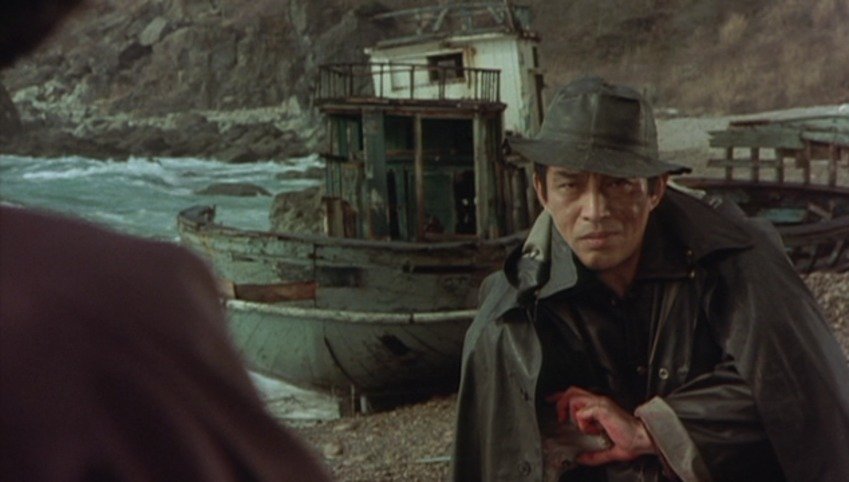
The film starts off with a young man causing mayhem on a busy street before an older man helps him out. The younger man is called Taguchi and looks like he has been ostracized from everyone in his life which is mainly the reason as to why he gets adopted as a son figure for Kondo, a pessimistic yakuza who runs a small boat to smuggle Korean girls across the Genkai sea for Sawaki, who is now turned into a sort of his boss and shares the same history with him. The two were first friends as medical students during the war and took turns working on the corpses of soldiers, and when offered a job by American soldiers in Busan’s slums in 1951. They were each other’s worst influence instead getting consumed by alcohol and when they found tags on dead soldiers, they would use them to locate the widows, rob, rape, and kill the women that went against them.
While recruiting women for the yakuza organization Sawaki works for, Kondo and Taguchi come across two peculiar individuals. One of them is Kojun, a woman who earns Kondo’s undivided attention through her ability to speak in Japanese, and soon, she becomes interested in Taguchi as well. Mr. Kim serves as a guardian for the women, but his true objectives soon become apparent. To make matters worse, the yakuza syndicate is exploiting the past of the main characters and subjecting them to even more gruesome events.
Even though the film begins as a comedy (definitely the ‘hail MacArthur’ moment will stick ) that is chiefly ridiculing the yakuza by depicting all the Yakuza and Sawaki in particular as cartoonish characters, not up to minutes takes a turn to drama with imageries of exploitation, and wraps up as a melodrama but with its insane elements intact. In that manner, the emphasis gets shifted from the previously mentioned satirical focus to the Koreans being tortured subsequently by the Japanese, the principal beginning with thieving, order busing in rape and murder systematic in the year 1951, and continuing now even during the sixties and seventies where the time setting of the film seems to take place.
You see, there are other characters as well who serve as sorts of Messengers for these narratives, and they were rather entertaining to observe. One instance I remember is Kondo, who portrays grief and remorse and reasonably acts on his past great sins. This is perhaps the reason he endeavors to help Taguchi but both his history and character prevent such endeavors to yield any result. Kondo however, is a completely different case. Kondo displays little to no regret of his actions and continues along the same lines to a greater extent resulting in him behaving even worse than before, his favorite pastime includes trying to pull Kondo down with him, which has lead them to physically fight quite a lot. Their environment does not help them significantly either, in fact, due to the necessity of their occupation, and their connections with the yakuza, it seems like their struggle for survival becomes more palpable. Kara on other hand does not seem to pipeline these facts as an justification for how everything turns out rather the intricate story and plot alongside the various surprises serves to amplify the problem.
Kondo portrays Noboru Ando while Jo Shishido enacts as Sawaki closely working together, and their contrasts provides an entertaining element of the movie even though their actions are rather rough, and as a result makes the role they enact a pretty tough one.
Kojun portrays the image of Zainichi Koreans alongside the struggle for acceptance in Japan and these enmities still prevail. They also represent the treatment of women in the paternalistic society, with all these odds they make it yet with determination such as in the case of Taguchi who holds remnants of hope in their case. But she ends up being a victim of domestic violence such as rape and gets trapped in the perverted and bare places which send the message of no choice to those of her kind. RC Shijt is married to Juro Kara and she has appeared in this film as a Korean woman Aido Asuka whom she narrates the history. The most believable part in this film is when she is on the streets searching for Something.
Taguchi is seen to epitomize the youth of that generation who fumbled through life without mentorship or any authority figure which upon failure leads them to an endless void filled with mistakes. The film’s plot goes hand in hand when Taguchi finds out that his mentor has raped the woman who he loves. Jinpachi Nezu is also remarkable in this role, serving as the last of this collection of loathsome anti-heroes who are the protagonists of the story.
This film Technically treats us to edge of the seat drama as the narrative comes with several twists and turns and even time shifts as flashbacks. This is in no small measure due to the editing skills of Michio Suwa and to the direction itself. Occasionally jerky cuts maintain a swift feel to the picture which complements its structurally disjointed format. Hiroshi Segawa’s cameral work effectively Dani’s nightmare world as he sought the right framing for each and every one of the many horrific actions performed by the characters, resulting to a lingering feeling of claustrophobia.
Definitely a very hard film to watch, “Sea of Genkai” is. However, and perhaps with the exception of the comedy of the first 20 minutes, the meticulousness Kara shot it with, the excellent acting, and the pointed comments, the work is only great.
For more movies like The Sea of Genkai (1976) visit solarmovie







